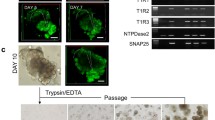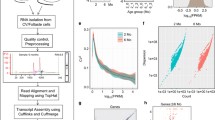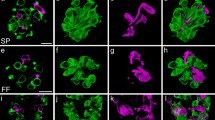Abstract
A taste bud is a sensory organ and consists of 50–100 spindle-shaped cells. The cells function as taste acceptors. They have characteristics of both epithelial and neuronal cells. A taste bud contains four types of cells, type I, type II, type III cells, and basal cells. Taste buds were isolated from a tongue of a p53-deficient mouse at day 12, and 11 clonal taste bud (TBD) cell lines were established. In immunochemical analysis, all cell lines expressed cytokeratin 18, gustducin, T1R3, and neural cellular adhesion molecule, but not GLAST. In RT-PCR analysis, shh was not expressed in any of the cell lines. Further analysis with RT-PCR was conducted on four cell lines. They expressed G protein-coupled taste receptors; T1R3, T2R8 for sweet, bitter, umami. And they also expressed α-ENaC for salty taste. While, a candidate for sour receptor HCN4 was expressed in TBD-a1 and TBD-a7 lines. And another candidate for sour receptor PKD1L3 was slightly expressed in TBD-a1 and TBD-c1.







Similar content being viewed by others
References
Adler E.; Hoon M. A.; Mueller K. L.; Chandrashekar J.; Ryba N. J. P.; Zuker C. S. A. Novel family of mammalian taste receptors. Cell 100: 693–702; 2000.
Booth B. W.; Mack D. L.; Androutsellis-Theotokis A.; McKay R. D. G.; Boulanger C. A.; Smith G. H. The mammary microenvironment alters the differentiation repertoire of neural stem cells. Proc Natl Acad Sci USA 105: 14891–14896; 2008.
Boulanger C. A.; Mack D. L.; Brian W.; Booth B. W.; Smith G. H. Interaction with the mammary microenvironment redirects spermatogenic cell fate in vivo. Proc Natl Acad Sci USA 104: 3871–3876; 2007.
Farbman A. I. Electron microscope study of the developing taste bud in rat fungiform papilla. Dev Biol 11: 110–135; 1965.
Finger T. E. Cell types and lineages in taste buds. Chem Senses 30(Suppl 1): i54–i55; 2005.
Finger T. E.; Simon S. A. Cell biology of taste epithelium. In: Finger T. E.; Silver W. L.; Restrepo D. (eds) The neurobiology of taste and smell. 2nd ed. John Wiley and Sons Inc, 605 Third Avenue New York; 2000.
Hall J. M.; Hooper J. E.; Finger T. E. Expression of sonic hedgehog, patched, and gli1 in developing taste papillae of the mouse. J Comp Neurol 406: 143–155; 1999.
Hanazono M.; Hirabayashi K.; Tomisawa H.; Aizawa S.; Tomooka Y. Establishment of uterine cell lines from p53-deficient mice. In Vitro Cell Dev Biol Anim 33: 668–671; 1997.
Hanazono M.; Nozawa R.; Itakura R.; Aizawa S.; Tomooka Y. Establishment of an androgen-responsive prostatic cell line “PEA5” from a p53-deficient mouse. Prostate 46: 214–225; 2001.
Horiuchi H.; Itoh M.; Pleasure D. E.; Tomooka Y. Multipotency of FBD-103a, a neural progenitor cell line from the p53-deficient mouse. Brain Res 1066: 24–36; 2005.
Horiuchi M.; Tomooka Y. An attempt to generate neurons from an astrocyte progenitor cell line FBD-104. Neurosci Res 53: 104–115; 2005.
Iwasaki S. Evolution of the structure and function of the vertebrate tongue. J Anat 201: 1–13; 2002.
Jung H. S.; Oropeza V.; Thesleff I. Shh, Bmp-2, Bmp-4 and Fgf-8 are associated with initiation and patterning of mouse tongue papillae. Mech Dev 81: 179–182; 1999.
Kataoka S.; Yang R.; Ishimaru Y.; Matsunami H.; Kinnamon J. C. Finger TE (2008) The candidate sour taste receptor, PKD2L1, is express by type III taste cells in the mouse. Chem Senses 33: 243–254; 2008.
Kinnamon J. C.; Taylor B. J.; Delay R. J.; Roper S. D. Ultrastructure of mouse vallate taste buds. I. Taste cells and their associated synapses. J Comp Neurol 235: 48–60; 1985.
Kishi M.; Emori Y.; Tsukamoto Y.; Abe K. Changes in cell morphology and cell-to-cell adhesion induced by extracellular Ca2+ in cultured taste buds. Biosci Biotechnol Biochem 66: 484–487; 2002.
Komine A.; Suenaga M.; Nakao K.; Tsuji T.; Tomooka Y. Tooth regeneration from newly established cell lines from a molar tooth germ epithelium. Biochem Biophys Res Commun 355: 758–763; 2007.
Lawton D. M.; Furness D. N.; Lindemann B.; Hackney C. M. Localization of the glutamate-aspartate transporter, GLAST, in rat taste buds. Eur J Neurosci 12: 3163–3171; 2000.
Lindemann B. Taste reception. Physiol Rev 76: 719–766; 1996.
Miura H.; Kusakabe Y.; Harada S. Cell lineage and differentiation in taste buds. Arch Histol Cytol 69: 209–225; 2006.
Nakamura S.; Kamakura T.; Ookura T. Tongue epithelial KT-cell-cycle arrest by TGF-beta associated with induction of p21(Cip1) and (Ink4b). Cytotechnology 61: 109–116; 2009.
Nakayama A.; Miura H.; Shindo Y.; Kusakabe Y.; Tomonari H.; Harada S. Expression of the basal cell markers of taste buds in the anterior tongue and soft palate of the mouse embryo. J Comp Neurol 509: 211–224; 2008.
Nelson G.; Chandrashekar J.; Hoon M. A.; Feng L.; Zhao G.; Ryba N. J. P.; Zuker C. S. An amino-acid taste receptor. Nature 416: 199–202; 2002.
Nelson G. M.; Finger T. E. Immunolocalization of different forms of neural cell adhesion molecule (NCAM) in rat taste buds. J Comp Neurol 336: 507–516; 1993.
Okubo T.; Clark C.; Hogan B. L. M. Cell lineage mapping of taste cells and keratinocytes in the mouse tongue and soft palate. Stem Cells 27: 442–450; 2009.
Ookura T.; Kawamoto K.; Tsuzaki H.; Mikami Y.; Ito Y.; Oh S. L.; Hino A. Fibroblast and epidermal growth factors modulate proliferation and neural cell adhesion molecule expression in epithelial cells derived from the adult mouse tongue. In Vitro Cell Dev Biol Anim 38: 365–372; 2002.
Ozdener H.; Yee K. K.; Cao J.; Brand J. G.; Teeter J. H.; Rawson N. E. Characterization and long-term maintenance of rat taste cells in culture. Chem Senses 31: 279–290; 2006.
Roper D. R. Signal transduction and information processing in mammalian taste buds. Pflügers Arch Eur J Physiol 454: 754–776; 2007.
Ruiz C. J.; Stone L. M.; McPheeters M.; Ogura T.; Böttger B.; Lasher R. S.; Finger T. E.; Kinnamon S. C. Maintenance of rat taste buds in primary culture. Chem Senses 26: 861–873; 2001.
Stone L. M.; Finger T. E.; Tam P. P. L.; Tan S. S. Taste receptor cells arise from local epithelium, not neurogenic ectoderm. Proc Natl Acad Sci USA 92: 1916–1920; 1995.
Stone L. M.; Tan S. S.; Tam P. P. L.; Finger T. E. Analysis of cell lineage relationship in taste buds. J Neurosci 22: 4522–4529; 2002.
Takahashi C.; Yoshida H.; Komine A.; Nakao K.; Tsuji T.; Tomooka Y. Newly established cell lines from mouse oral epithelium regenerate teeth when combined with dental mesenchyme. In Vitro Cell Dev Biol Anim 46: 457–468; 2010.
Tanahashi K.; Shibahara S.; Ogawa M.; Hanazono M.; Aizawa S.; Tomooka Y. Establishment and characterization of clonal cell lines from the vagina of p53-deficient young mice. In Vitro Cell Dev Biol Anim 38: 547–556; 2002.
Tsukada T.; Tomooka Y.; Takai S.; Ueda Y.; Nishikawa S.; Yagi T.; Tokunaga T.; Takeda N.; Suda Y.; Matsuo I.; Ikawa Y.; Aizawa S. Enhanced proliferative potential in culture of cells from p53-deficient mice. Oncogene 8: 3313–3322; 1993.
Umezu T.; Hanazono M.; Aizawa S.; Tomooka Y. Characterization of newly established clonal oviductal cell lines and differential hormonal regulation of gene expression. In Vitro Cell Dev Biol Anim 39: 146–156; 2003.
Umezu T.; Tomooka Y. An evidence of stromal cell populations functionally linked with epithelial cell populations in the mouse oviduct. Zoolog Sci 21: 319–326; 2004.
Umezu T.; Yamanouchi H.; Iida Y.; Miura M.; Tomooka Y. Follistatin-like-1, a diffusible mesenchymal factor determines the fate of epithelium. Proc Natl Acad Sci USA 107: 4601–4606; 2010.
Wong G. T.; Gannon K. S.; Margolskee R. F. Transduction of bitter and sweet taste by gustducin. Nature 381: 796–800; 1996.
Yang R.; Crowley H. H.; Rock M. E.; Kinnamon J. C. Taste cells with synapses in rat circumvallate papillae display SNAP-25-like immunoreactivity. J Comp Neurol 424: 205–215; 2000.
Acknowledgements
We would like to thank Dr. R. F. Malgorske (Mount Sinai School of Medicine) for providing anti-T1R3 antibody and Dr. S. Aizawa (RIKEN Center for Developmental Biology) for providing p53 −/− mice. Financial assistance was provided by KAKENHI (Grant 19570062), and by Program for Development of Strategic Research Center in Private Universities supported by MEXT (2010).
Author information
Authors and Affiliations
Corresponding author
Additional information
Editor: Tetsuji Okamoto
Rights and permissions
About this article
Cite this article
Sako, H., Hori, M., Masuho, I. et al. Establishment of clonal cell lines of taste buds from a p53 −/− mouse tongue. In Vitro Cell.Dev.Biol.-Animal 47, 333–340 (2011). https://doi.org/10.1007/s11626-011-9398-3
Received:
Accepted:
Published:
Issue Date:
DOI: https://doi.org/10.1007/s11626-011-9398-3




